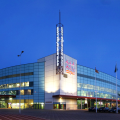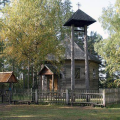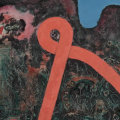The new permanent display Latvian art. 19th – 20th Century for the first time covers two centuries of the evolution of art in Latvia. The main objective was to create a visual, emotional story of Latvian art development and its social, geopolitical and historical context. In the display, the most important authors and art works from each period are selected.
It is modern and visitor friendly display, arranged chronologically by the principle of stylistic and narrative forms. A novelty in the display are the artworks from the time period 1945–2000, covering the art that has been created while Latvia was under the Soviet occupation and in the first decade of independence in 1990’s. In addition to traditional art forms – painting, sculpture and graphic art – also art works of the photo, installation and video are exhibited.
Display begins with an insight in Baltic German art scene in the 19th Century in the territory of present-day Latvia. It continues with a significant key moment in Latvian art development in the turn of the centuries – the birth of a conscious national art school. The first Latvian painters (trained at the St. Petersburg Imperial Academy of Art) supplemented their Academic Realism experience with influences of Impressionism and other movements in Europe. The key figures from this period are Vilhelms Purvītis (1872–1945), Janis Rozentāls (1866–1916) and Johans Valters (1869–1932).
Outstanding episode in Latvian art is the period of Classical Modernism. After the founding of the independent national state (1918), artists loyal to the Parisian school continued to introduce contemporary innovations recreating impressions of the movement of classical modernism – Expressionism, Fauvism and Cubism. Artists as Jāzeps Grosvalds (1891–1920), Jēkabs Kazaks (1895–1920), Niklāvs Strunke (1894–1966), Romans Suta (1896–1944), Aleksandra Beļcova (1892–1981), Ģederts Eliass (1887–1975) are among the most important ones.
After the First World War, some of the Latvian artists became involved in developing new art movements in Soviet Russia. Today they are known in the world as significant masters of the Russian Avant-garde. The most famous one is Gustavs Klucis (1895–1938).
The part of the permanent display with the art works from the second half of the 20th century begins with the introduction of Socialist Realism – the depiction of subjects commensurate with communist ideology. In 1956, after Stalin’s cult of personality, Socialist Modernism became current. It featured expressive and abstract forms that were permitted to appear within the bounds of themes acceptable to socialism. As an anti-modernist reaction, the 1970s saw the blossoming of Socialist Post-Modernism – the return to the mimetic image but rejecting ideological themes and developing independent concepts and subjective motifs. The artists which can be highlighted form this period are Jānis Pauļuks (1906–1984), Boriss Bērziņš (1930–2002), Džemma Skulme (1925), Edgars Iltners (1925–1983), Ojārs Ābols (1922–1983), Maija Tabaka (1939).
In the second half of the 1980s Latvian art was in the avant-garde of political events. The young generation artists of this age were known as trespassers. A powerful wave of Neo-Expressionism depicts metaphors of the collapsing Soviet empire and the drama of a passing age. Conceptualists interpreted the age more rationally. In the 90s painters turned to a taboo of the Soviet years – Abstract art. There were radical changes in the hierarchy of art media; installations, objects and performances dominated. As the most important artists of this period we can mention Ilmārs Blumbergs (1943–2016), Aija Zariņa (1954), Kristaps Ģelzis (1962) and Andris Breže (1958).
The information about the display is accessible in different cognitive levels. The artworks have a central role in the display but it is complemented with a multimedia infrastructure to extend the visitor’s experience.
In the new permanent display around 500 art works from the museum’s collection are set. It is housed in the 2nd and 3rd floor of museum’s historic building.












